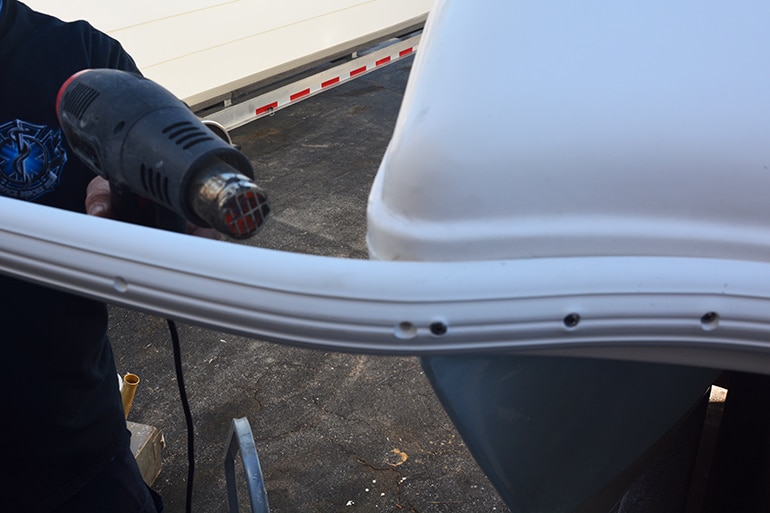rub rail on a boat is a protective strip that runs along the edge where the hull meets the deck, often working alongside boat railings to protect and enhance the vessel. Its primary role is to shield your boat from impacts when docking, tying up, or coming alongside another vessel, while railings provide safety and support for passengers. While it might seem like a small detail, the rub rail plays a big part in preventing costly damage and keeping your boat looking great.
Primary Functions of a Rub Rail
While rub rails might seem like a simple trim feature, they actually play several essential roles in protecting and preserving your boat. From shielding the hull against damage to enhancing the vessel’s look and extending its lifespan, each function contributes to both performance and appearance. Let’s explore the primary benefits in detail.
Hull Protection
The rub rail absorbs and distributes the force of bumps and scrapes against docks, pilings, or other boats. Without it, the hull’s gelcoat or paint could easily chip, scratch, or crack.
Aesthetic Enhancement
Beyond protection, rub rails contribute to your boat’s style. Sleek stainless steel or polished vinyl can add a professional, finished look that enhances overall appeal.
Structural Preservation
By protecting high-contact edges, rub rails help maintain the boat’s structural integrity over time, reducing the risk of water intrusion and expensive repairs.
Types of Rub Rails
Material-Based
- Vinyl Rub Rails – Affordable, flexible, and available in various colors, ideal for most recreational boats.
- Stainless Steel Rub Rails – Durable, corrosion-resistant, and upscale in appearance, often found on luxury or offshore vessels.
- Aluminum Rub Rails – Lightweight and strong, suitable for both style and function.
- Rubber Rub Rails – Shock-absorbing and low-maintenance, commonly used on workboats and utility craft.
Design-Based
- Flexible Profiles – Bend easily to fit curves and contours, ideal for DIY installation.
- Rigid Profiles – Stronger and more impact-resistant, typically installed professionally.
- One-Piece Systems – Simple design for small boats or budget-conscious owners.
- Two-Piece Systems – Feature a base track and insert for added durability and customization.
How Rub Rails Are Installed
Rub rails may be installed during boat manufacturing or as aftermarket upgrades.
- Mounting Techniques – Screw-on systems for secure attachment, adhesive options for a clean finish, and insert systems that allow for easy replacement of damaged sections.
- DIY vs. Professional – Small boat owners may handle installation themselves, but for longer or complex rails, hiring a marine technician ensures perfect alignment and watertight sealing.
Maintenance and Replacement
- Cleaning Tips – Regularly wash with mild soap and water to remove salt, dirt, and debris. Apply UV protectant to prevent fading and cracking.
- Signs of Wear – Cracks, discoloration, loose sections, or exposed hull edges are indicators it’s time for replacement.
- Replacement Process – Requires removing old fasteners, prepping the surface, and installing new rail with the right tools for a secure fit.
Cost Factors for Rub Rails
The price of a rub rail depends on:
- Material Choice – Stainless steel is more expensive than vinyl or rubber.
- Boat Size – Larger boats require more length and higher costs.
- Installation Complexity – Curved hulls or intricate profiles may increase labor charges.
Final Thoughts
A rub rail is more than just a strip of material—it’s a vital protective feature that preserves both your boat’s beauty and its structure. With the right choice, proper installation, and regular care, a rub rail can save you from costly repairs and extend the life of your vessel.
FAQs About Rub Rails on Boats
- What does a rub rail do on a boat?
It protects the hull from impact damage during docking and mooring. - Are rub rails necessary for all boats?
Yes, any boat that docks or comes into contact with structures benefits from a rub rail. - What is the best material for a boat rub rail?
It depends on your budget and style preference—stainless steel for durability, vinyl for affordability, and rubber for impact absorption. - How do you install a rub rail on a boat?
It can be screwed on, glued, or fitted with an insert track, depending on the design. - Can I replace a rub rail myself?
Yes, small boat owners often DIY, but larger boats may require professional installation. - How much does a boat rub rail cost to replace?
Anywhere from $5 to $50 per foot, depending on material, boat size, installation method, and labor rates. - How long should a boat rub rail last?
With proper care, vinyl rails can last 5–10 years, and stainless steel can last decades. - What’s the difference between vinyl and stainless steel rub rails?
Vinyl is flexible and affordable, while stainless steel offers unmatched durability and a premium look. - How do I clean and maintain my boat’s rub rail?
Use mild soap and water, rinse thoroughly, and apply UV protectant regularly. - Can a damaged rub rail be repaired instead of replaced?
Minor dents or scratches can be fixed, but cracks or loose sections usually require replacement.



